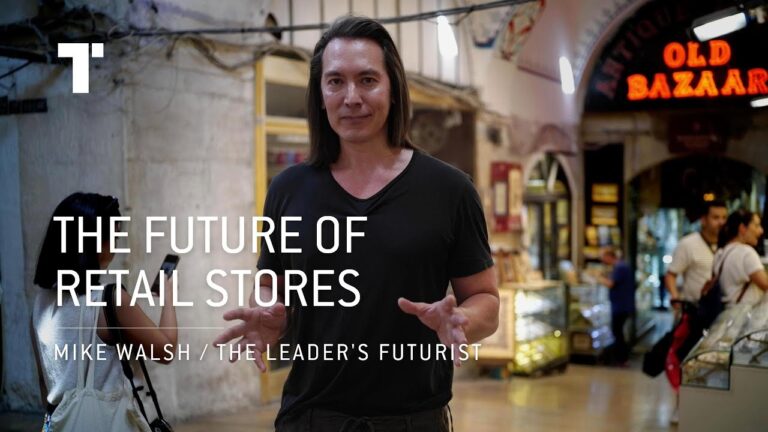For some, the digital future of retail is a story that ends in mobile apps, home delivery and perhaps even immersive, shopping experiences in the metaverse. I’m not sure sure, after all, physical stores have been around for at least 10,000 years. But as you will learn in this video – if we are going to understand the disruptive future of retail, there are 3 myths that we need to dispel away.
Mike Walsh
Learn whether the Physical Retail Stores be still there after a 1000 years with the advances in technology, Digital Platforms and Increased Focus on Omnichannel Experience or are these Just Myths. Learn More in this Video
The future of physical retail stores is evolving rapidly due to technological advancements, changing consumer behaviors, and shifts in the retail landscape. Here are several key trends and developments shaping the future of physical retail:
1. Omnichannel Integration
Retailers are increasingly focusing on integrating their physical stores with online channels to create a seamless shopping experience. This includes:
- Click-and-Collect: Allowing customers to purchase items online and pick them up in-store.
- Buy Online, Return In-Store: Offering the convenience of returning online purchases at physical locations.
- Unified Inventory Systems: Synchronizing online and in-store inventories to ensure accurate availability.
2. Enhanced In-Store Experiences
To attract and retain customers, physical stores are transforming into experiential spaces. This includes:
- Interactive Displays: Using technology like augmented reality (AR) to create engaging product experiences.
- Experiential Zones: Creating dedicated areas for customers to try out products, such as beauty product testers or tech gadget demos.
- Events and Workshops: Hosting events, classes, or demonstrations to build community engagement and loyalty.
3. Technology Integration
Physical stores are increasingly adopting technology to improve efficiency and enhance the customer experience:
- Smart Mirrors and Virtual Try-Ons: Allowing customers to virtually try on clothes or see how furniture fits in their space.
- Beacon Technology: Using Bluetooth signals to send personalized offers or information to customers’ smartphones when they are near a store.
- Automated Checkout: Implementing self-checkout kiosks or mobile payment options to streamline the purchasing process.
4. Sustainability and Ethical Practices
Consumers are becoming more environmentally conscious, prompting retailers to adopt sustainable practices:
- Eco-Friendly Store Designs: Using sustainable materials and energy-efficient technologies in store construction and operations.
- Circular Economy Models: Offering recycling programs, repair services, or second-hand goods to reduce waste.
- Ethical Sourcing: Ensuring that products are sourced responsibly and ethically.
5. Personalization
Retailers are leveraging data and AI to offer personalized shopping experiences:
- Personalized Recommendations: Using purchase history and preferences to suggest products tailored to individual customers.
- Customized Products: Allowing customers to personalize or customize products in-store.
- Targeted Promotions: Offering special deals or discounts based on customer behavior and preferences.
6. Store Format Innovation
The physical retail space is diversifying with new formats and concepts:
- Pop-Up Stores: Temporary retail spaces that allow brands to test new markets or concepts.
- Showrooming: Stores that focus on showcasing products and driving online sales rather than direct purchases.
- Smaller Footprint Stores: Compact stores in high-traffic areas that offer a curated selection of products.
7. Hybrid Retail Models
Retailers are experimenting with hybrid models that blend physical and digital elements:
- Interactive Kiosks: In-store kiosks that allow customers to browse online inventory or place special orders.
- Virtual Reality (VR) Shopping: Creating virtual store environments where customers can browse and interact with products online.
8. Enhanced Customer Service
Customer service is evolving to meet the expectations of today’s shoppers:
- Customer Service Bots: Using AI-powered chatbots for instant assistance and inquiries.
- Live Chat: Offering real-time support through online and in-store channels.
- Personal Shoppers: Providing personalized shopping assistance to enhance the customer experience.
9. Data-Driven Insights
Retailers are utilizing data analytics to optimize store operations and customer interactions:
- Foot Traffic Analysis: Monitoring in-store traffic patterns to optimize store layout and staffing.
- Sales Data: Analyzing sales trends to make informed decisions about inventory and promotions.
- Customer Feedback: Collecting and analyzing customer feedback to improve products and services.
10. Health and Safety Considerations
Post-pandemic, there is a heightened focus on health and safety measures in physical retail:
- Sanitization Stations: Providing hand sanitizers and cleaning protocols to ensure store cleanliness.
- Contactless Interactions: Reducing physical contact through contactless payment options and curbside pickup.
- Social Distancing Measures: Implementing store layouts and policies to accommodate social distancing guidelines.
Conclusion
The future of physical retail stores will be characterized by a blend of technology, personalized experiences, and innovative store formats. Retailers that adapt to these changes and effectively integrate their online and offline channels will be well-positioned to thrive in the evolving retail landscape. The key will be to focus on creating value for customers through convenience, engagement, and sustainability while embracing new technologies and retail trends.


